Housing: Background
Housing Report
Background
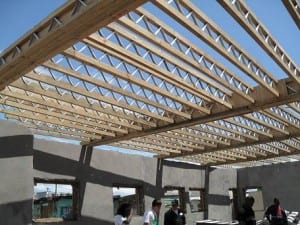 When the apartheid era ended, rapid urbanization occurred as many formerly mobility-restricted Blacks fled to the cities to see what opportunities they could find. This caused a host of problems such as high unemployment rates, shortage of housing and severe overcrowding issues. The post-apartheid era brought a sudden increase of informal settlements into South Africa because of insufficient housing. Seasonal workers began to form squatter camps. The name informal settlement shows that these settlements were intended to be temporary. By late 1990s, there were many squatters on the land and the temporary housing had become permanent in many respects (Cheru, 2005).
When the apartheid era ended, rapid urbanization occurred as many formerly mobility-restricted Blacks fled to the cities to see what opportunities they could find. This caused a host of problems such as high unemployment rates, shortage of housing and severe overcrowding issues. The post-apartheid era brought a sudden increase of informal settlements into South Africa because of insufficient housing. Seasonal workers began to form squatter camps. The name informal settlement shows that these settlements were intended to be temporary. By late 1990s, there were many squatters on the land and the temporary housing had become permanent in many respects (Cheru, 2005).
Monwabisi Park is one of many informal settlements in Cape Town, South Africa and is just a small example of the effects of the end of the apartheid era and rapid urbanization. Today, it remains a very difficult situation for the residents of this community. A large amount work has been started by The Shaster Foundation to improve Monwabisi Park and to help
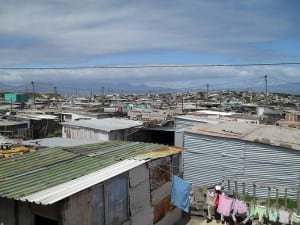 transform this community into an eco-village. The Shaster Foundation decided to start the Indlovu Project in Monwabisi Park. The Indlovu Project is a redevelopment project in the area of Section C of Monwabisi Park known as the redevelopment seed. Other partners in this redevelopment effort include the City of Cape Town, ecoBEAM, Violence Protection through Urban Upgrading (VPUU), WPI, with seven projects in 2009, six in 2008 and one in 2007 geared around the redevelopment efforts, and the community of Monwabisi Park. Although these efforts have made a large impact, in order to truly make Monwabisi Park into a sustainable society a lot of planning needs to be done.
transform this community into an eco-village. The Shaster Foundation decided to start the Indlovu Project in Monwabisi Park. The Indlovu Project is a redevelopment project in the area of Section C of Monwabisi Park known as the redevelopment seed. Other partners in this redevelopment effort include the City of Cape Town, ecoBEAM, Violence Protection through Urban Upgrading (VPUU), WPI, with seven projects in 2009, six in 2008 and one in 2007 geared around the redevelopment efforts, and the community of Monwabisi Park. Although these efforts have made a large impact, in order to truly make Monwabisi Park into a sustainable society a lot of planning needs to be done.
Various individuals and parties were involved in the development the Buildings Team Project and this report. Robert Taylor and Mike Tremeer from ecoBEAM were involved in discussions concerning building technologies and building layouts. Buyiswa Tonono from the Indlovu Project as well as Di Womersley and The Shaster Foundation were involved in discussions regarding community involvement and interests. Dinny Laurence, an attorney volunteer of the Indlovu Project, was influential in discussions concerning the legal aspects of redevelopment efforts, management, and upkeep.
Existing Conditions
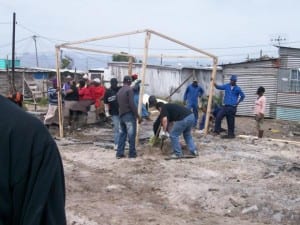
Within Monwabisi Park, there are approximately 20,000 people living in 6,000 shacks. These shacks have become a staple building type because of how quickly and easily they can be built. A three by three meter home can be built for under R1, 200 in just a matter of days. New homes are typically built with the help of friends, family and neighbours using only a hammer, saw and shovel. To start construction, a simple framework is built. The exterior of the shack is then made from corrugated iron and timber. These materials are relatively inexpensive and readily available. On the inside, the flooring is typically linoleum or carpet. The walls are lined with ceiling board or cardboard and often the roof rafters are left exposed (Garcia et al., 2008).
The shacks vary in size, height and shape. Shacks have an average size of 35 m2, but range in size from 11 m2 to 61 m2. Each shack is a unique expression of its owners. Some shacks are one room, while others consist of a lounge, kitchen and even multiple bedrooms. Consistent
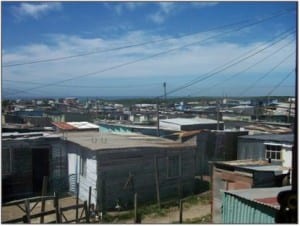 throughout almost all of the shacks is a lounge room. The lounge promotes gatherings, parties and social interaction among friends; a cherished part of South African culture. There is an average of 3.7 people per shack in Monwabisi Park, which, in the small area of a shack the open layout is important to allow for space (VPUU, 2009). Another important aspect of the home is the land and space around it. Earth, land and free space are three integral parts of South African culture and religion. For this reason, almost every resident has a yard surrounding their shack. These yards provide room for gardening, room for drying clothes and a safe place for children to play.
throughout almost all of the shacks is a lounge room. The lounge promotes gatherings, parties and social interaction among friends; a cherished part of South African culture. There is an average of 3.7 people per shack in Monwabisi Park, which, in the small area of a shack the open layout is important to allow for space (VPUU, 2009). Another important aspect of the home is the land and space around it. Earth, land and free space are three integral parts of South African culture and religion. For this reason, almost every resident has a yard surrounding their shack. These yards provide room for gardening, room for drying clothes and a safe place for children to play.
Despite their practicality, the shacks of Monwabisi Park face a variety of problems. Most of the common problems are from rainfall. Not only do the roofs leak, but often homes will feel damp after a storm. Even with brand new tin, roofs may still leak due to damage that occurs during the construction process. In fruitless efforts, some families use newspaper to fill holes in their roofs. Moreover, the rain can cause electrical problems. Of the people who have electricity, it is typically poorly wired. The informal electricity and leaky roofs are a
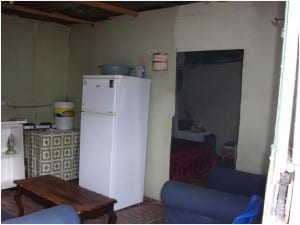 dangerous combination. Another problem is flooding. During torrential rain, roads will flood and water seeps into the shacks through baseboards. In some cases, shacks sit upon flat stone, brick or even concrete foundations. By building their homes a few inches off the ground, some residents are able to avoid this flooding problem. Another difficulty Monwabisi Park residents face is sand. Monwabisi Park is exposed to a strong southeast summer wind. Sand blows through windows, doors, walls and even the cracks in the roof. A final problem is insulation and ventilation. During the summer months, the weather is hot and the shacks are difficult to ventilate. During the winter months, the weather is cold and the shacks are difficult to heat (Garcia et al., 2008).
dangerous combination. Another problem is flooding. During torrential rain, roads will flood and water seeps into the shacks through baseboards. In some cases, shacks sit upon flat stone, brick or even concrete foundations. By building their homes a few inches off the ground, some residents are able to avoid this flooding problem. Another difficulty Monwabisi Park residents face is sand. Monwabisi Park is exposed to a strong southeast summer wind. Sand blows through windows, doors, walls and even the cracks in the roof. A final problem is insulation and ventilation. During the summer months, the weather is hot and the shacks are difficult to ventilate. During the winter months, the weather is cold and the shacks are difficult to heat (Garcia et al., 2008).
It is reasonable to conclude that if these difficulties were addressed living conditions within Monwabisi Park would improve. As we begin our redevelopment efforts, there are two paths that could facilitate these changes. One option is to start from the bottom-up and build new homes. Another option is to keep the current shacks and develop new methods for fixing and addressing these problems. The goal of our project is new housing for as many people as is possible, though some people may choose to upgrade their homes and some may not.
Housing Demographics
Within Monwabisi Park there can be a range of anywhere from one to 16 people living in one household (VPUU, 2009). On average there are 3.7 people per home. Each shack is typically occupied by at least two adults. Of the 546 community members surveyed by the VPUU, it was found that 57 percent of the residents are adults, 32 percent are children over six years old and 11 percent are children younger than six. It is rare to find a household with more than six older children or more than two younger children. For the most part, there is only one shack built on each site. However, some sites have two or three shacks on them to accommodate family.



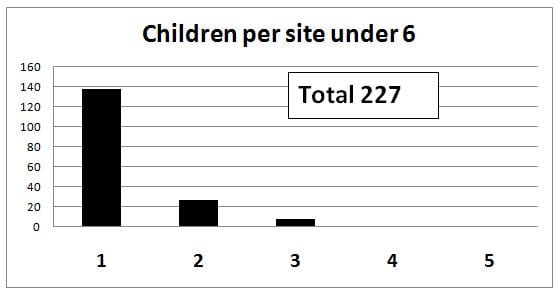
Although homes are the most common structure in Monwabisi Park, there are also other types of buildings. Some residents live in shop houses. Shop houses have a store and living quarters in the same building. They are unique in that they conserve space and allow the occupants to work where they live. Not only is this convenient, but it also increases security. By living at the shop, the homeowner is blessed with around-the-clock surveillance. There are also many stores that are stand alone where the owner locks up and goes home each night. A distribution of each type of shops is shown below.
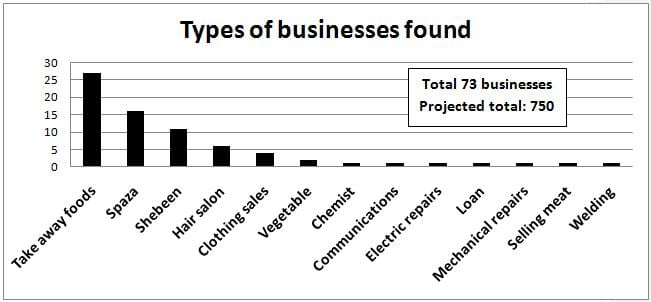
Next Section: Plan Implementation
Back to: Housing Report
Author: WPI CT09 Buildings


